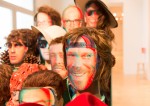Not only is every gallery of the UCLA Hammer Museum filled with art, but so are the lobby, the courtyard and even the hallways.
“Made in L.A. 2014” is the Hammer Museum’s second biennial exhibition of the same name. It’s the Hammer’s first show to ever take over the museum in its entirety and will run through Sept. 7. As with all Hammer exhibitions, “Made in L.A. 2014” is free of charge and is accompanied by programs and events for the public, from live performances and screenings to walk-throughs and art talks.
“Made in L.A. 2014” is curated by Hammer chief curator Connie Butler and independent curator Michael Ned Holte and highlights new and lesser-known Los Angeles-based artists. Holte said the exhibition features 35 entities, including collaborations, collectives and self-contained “shows within the show” of independently curated works, and more than 100 artists.
Rather than having a set theme, Butler and Holte said “Made in L.A. 2014” attempts to “capture the moment” of the L.A. art world and what makes Los Angeles an exciting place to be an artist, interacting with the exhibition’s visitors with changing dynamics and programs.
The exhibition’s next event, which will take place on July 1, is “Judy Fiskin: The Art Talk Trilogy,” a screening of Fiskin’s films followed by a Q&A; session in the Billy Wilder Theater. Tickets are available on a first-come, first-served basis and are free of charge.
“I’ll Remember Mama,” the latest short film by photographer and videographer Fiskin, screens every 15 minutes as part of “Made in L.A. 2014.” The film centers around the idea of growing old – both for herself and for her mother – but also centers around Fiskin’s fascination for objects and what they mean to people.
“I said to (Butler) I’m old, I’m tired, I’m thinking I’m going to retire,” Fiskin said. “And then he asked me to be in the show and within 24 hours I had written a script.”
A variety of special events, such as Fiskin’s screening, occur throughout “Made in L.A. 2014’s” run, while the walk-through of the exhibition begins as soon as visitors enter the Hammer’s doors. Inside the lobby is the work of “Public Fiction,” a periodically rotating compilation of art and texts.
Throughout the galleries and corridors, ceramics, painting and sculpture interact with videos, performance art, KCHUNG Radio and TV live tapings. Outside, experimental dancers visit James Kidd Studio’s courtyard stage for open rehearsal, and artist Piero Golia works on an ongoing Mount Rushmore-sized foam structure of George Washington’s nose and hosts volunteer artist opportunities for visitors.
Butler and Holte said their process to curate “Made in L.A. 2014” began with hundreds of studio visits around the L.A. area, interested in representing the diverse strategies of art-making in Los Angeles as well as reflecting different ages, genders, backgrounds and levels of experience.
“(We) really just wanted to create a compelling exhibition where there were dynamic relationships between the works of art we included,” Holte said.
Butler said that while the caliber and large number of working artists in Los Angeles made their decision process difficult, the depth of their selection pool helped lessen the pressure of creating a biennial exhibition.
“Los Angeles is such a big, diverse and international community of artists that in some way, it sort of relieves you of the responsibility of trying to be completely comprehensive because you can’t be,” Butler said. “So what you end up doing is taking something of a snapshot of a given moment in time.”
Once the artists were decided and recruited for the exhibition – many working on their pieces up until the opening of the exhibition – Butler said she and Holte began to regularly meet at the Hammer to organize the layout and strategies for “Made in L.A. 2014.”
Because the exhibition was a massive undertaking, Butler said it affected every member of the museum’s staff and became a huge team effort. She said the biennial fills the Hammer in hopes to enliven the museum’s spaces and engage the greater L.A. area, and even international communities.
To honor a few of the working L.A. artists featured in “Made in L.A. 2014,” awards accompany the biennial celebration. The Mohn Award and the Career Achievement Award are judged by a professional board, while the Public Recognition Award is voted on by the public.
Butler and Holte said “Made in L.A.” strives not only to provide a platform for current and emerging L.A. artists but also to act with an eye toward the Hammer’s future biennial celebrations.
“We knew there (will) be a ‘Made in L.A. 2016’ while doing this,” Holte said.
